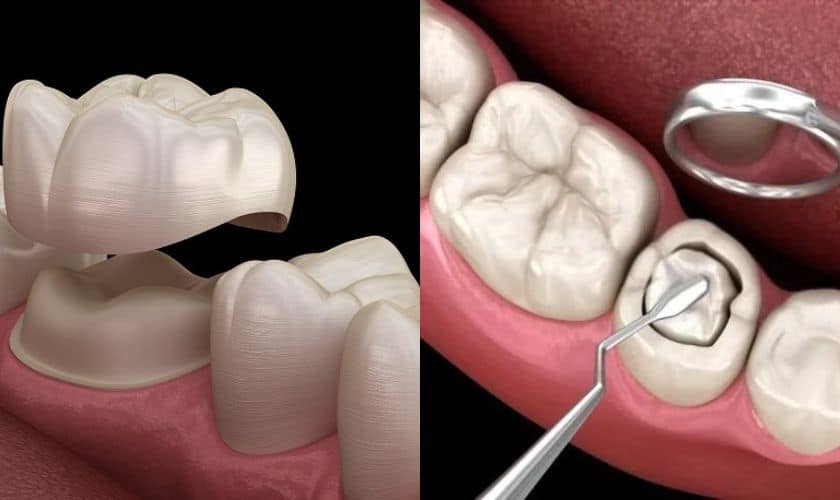When it comes to dental restorations, patients often find themselves weighing their options between dental crowns and fillings. Both are designed to restore the function and appearance of damaged teeth, but they serve different purposes and are used in different situations. In this blog post, we’ll explore the key differences between dental crowns and fillings, helping you decide which option might be the best choice for your dental needs.

Understanding Dental Crowns and Fillings
What Are Dental Crowns?
Dental crowns are custom-made caps placed over damaged or weakened teeth. They encase the entire tooth, providing strength and protection. Crowns are often recommended for teeth that have undergone significant decay, fractures, or root canal treatments. They can be made from various materials, including porcelain, metal, or a combination of both, depending on the specific needs and aesthetic goals of the patient.
What Are Fillings?
Dental fillings are materials used to restore teeth that have cavities or minor decay. Fillings are placed directly into the cavity to fill the void left by the decay, restoring the tooth’s shape and function. Common materials used for fillings include composite resin, amalgam, and glass ionomer. Fillings are typically used for smaller areas of decay and are designed to be less invasive than crowns.
When to Choose Dental Crowns
There are several situations where dental crowns might be the preferred option:
- Severe Decay: If a tooth has extensive decay that cannot be effectively treated with a filling, a dental crown may be necessary. Crowns provide the necessary strength and stability to support the tooth.
- After Root Canal Treatment: When a tooth has undergone a root canal, it often becomes weak and more susceptible to fractures. A crown is usually placed over the tooth to protect it and restore its function.
- Tooth Fractures: If a tooth is cracked or severely fractured, a crown can restore its integrity and prevent further damage.
- Cosmetic Improvements: Crowns can be used to improve the appearance of misshapen or discolored teeth, providing a more aesthetically pleasing smile.
If you’re considering getting dental crowns in Ellenbrook, consult with a qualified dentist to evaluate your specific needs and determine the best treatment plan.
When to Choose Fillings
Fillings may be the better choice in the following scenarios:
- Minor Decay: If a tooth has a small cavity or minor decay, a filling can effectively restore its function without the need for more extensive treatment.
- Less Invasive: Fillings require less tooth reduction than crowns, making them a more conservative option when only a small portion of the tooth is affected.
- Cost-Effective: Generally, fillings are less expensive than crowns, making them a more affordable option for patients with minor dental issues.
- Quick Treatment: The process for getting a filling is usually quicker than that for a crown, which often requires multiple appointments and lab work.
If you’re looking for an affordable Ellenbrook dentist, they can help assess whether a filling is suitable for your dental needs.
Pros and Cons of Dental Crowns
Pros
- Strength and Durability: Crowns provide maximum strength and can last many years with proper care.
- Protection: They protect weak or damaged teeth from further harm and restore function.
- Aesthetic Appeal: Crowns can be customized to match the color and shape of your natural teeth, enhancing your smile.
Cons
- Cost: Crowns are generally more expensive than fillings, as they involve more materials and labor.
- Invasive Procedure: The process of placing a crown often requires more tooth structure to be removed compared to fillings.
- Time-Consuming: Getting a crown typically involves multiple visits to the dentist, including an initial appointment for preparation and a follow-up appointment for placement.
Pros and Cons of Fillings
Pros
d Fillings are a less invasive option, preserving more of the natural tooth structure.
Cost-Effective: They are generally more affordable than crowns, making them accessible for patients with minor decay.
Quick Procedure: The filling process is usually completed in one visit, allowing for immediate restoration.
Cons
Limited Lifespan: Fillings may need to be replaced every few years, especially if they wear down or crack.
Not Suitable for Severe Damage: Fillings cannot adequately support teeth with extensive decay or damage.
Making the Right Choice
When deciding between dental crowns and fillings, consider the following factors:
- Extent of Damage: If your tooth has extensive decay or damage, a crown may be the best option. If the damage is minor, a filling may suffice.
- Cost and Insurance: Discuss your options with your dentist and check your insurance coverage to understand the potential costs associated with each treatment.
- Long-Term Goals: Consider the long-term health of your tooth. Crowns offer more protection and longevity, while fillings may be a good temporary solution.
- Personal Preferences: Your comfort and preference play a significant role. Discuss your options with your dentist to make an informed decision.
If you’re still unsure which option is best for you, consider consulting with a professional specializing in implant dentistry in Ellenbrook. They can provide insights into the most suitable solutions based on your individual needs.
Conclusion
Both dental crowns and fillings have their unique benefits and drawbacks. Choosing between the two ultimately depends on the specific condition of your teeth, your budget, and your long-term dental goals. Whether you require a crown for significant damage or a filling for minor decay, working with a qualified dentist ensures you receive the best treatment for your needs.
If you’re interested in exploring your options for dental restorations, don’t hesitate to reach out to your local Ellenbrook dentist. They can help guide you toward the most appropriate solution, ensuring a healthy and beautiful smile for years to come.
Also Read: Exploring the Pros and Cons of Dental Veneers: A Comprehensive Guide